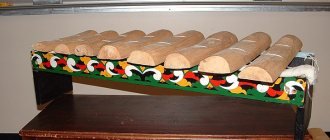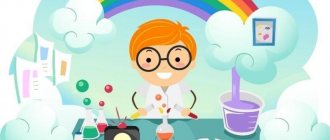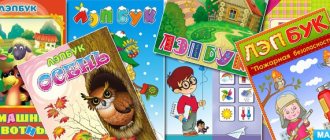The didactic game “Say it in one word” is intended for preschoolers of the older age group. It helps to consolidate terms that are generalizing for several objects on several topics: “Animal world”, “Flora world”, “Transport”, “Clothing”, “Housing” and others. Through play, a child learns to think, build logical chains, explain opinions, classify, his horizons and personal vocabulary expand.
Didactic game “Say it in one word”
You can play with one child or a group of children. The educational activity is suitable for preschoolers 5 years old and older; it can also be used in the first grade of school.
The goal of the didactic game “Name it in one word” is to consolidate the skill of classifying objects.
Tasks:
- developing the skill of classifying objects in the surrounding world;
- expansion of an individual dictionary on several topics at once;
- learning the ability to think, explain, unite;
- broadening one's horizons, developing curiosity and interest in the game form of learning;
- improvement of visual and auditory perception, memory, speech skills;
- developing the ability to concentrate, think logically, and think;
- fostering perseverance, correct behavior, and the ability to work productively in a team.
"Find the extra object"
For a game that develops the ability to analyze, compare, and identify objects based on certain characteristics, it is necessary to prepare cards. They should show 4 objects, one of which is redundant. For example:
- horse, giraffe, [wolf], camel;
- apple, [rose], plum, peach;
- [cherry], bell, cornflower, dandelion.
The student’s task is to find the wrong object and explain the choice. For example: a wolf is different from a horse, giraffe and camel because it has paws rather than hooves, and it hunts and does not eat grass.
Game options
The simplest version of the lesson is for the teacher to show a card, and the student names the illustrated object. For example: “Who is drawn here?” - “Crow”, “Swallow”, “Tit”, “Crane”, “Bullfinch”, “Cuckoo” - “Name what you drew in one word?” - "Birds". Or: “What is drawn here?” - “Boletus”, “Chanterelles”, “Honey mushrooms”, “Boletus”, “Volnushka”, “Green milk” - “And together is this?” - "Mushrooms".
For the didactic game “Name 1 word”, you can make cards in the following categories:
- pets;
- forest animals;
- birds of our region;
- insects;
- river fish;
- Marine life;
- fruits;
- flowers;
- edible mushrooms;
- vegetables;
- berries;
- trees;
- transport;
- Kids toys;
- cookware;
- furniture;
- food products;
- sports accessories;
- school supplies;
- wardrobe;
- musical instruments;
- household tools.
You can organize a team game. Have the students divide into two groups. The teacher shows cards to groups of players in random order. Children must list the objects and give them a common name. The team with the most correct answers wins.
When playing with cards, you can combine objects not only by general properties, but also by color, edibility or inedibility, living or inanimate state.
You can also make a fun puzzle game. For it, you need to cut out pictures of such a shape that images of the same category are combined into a single canvas. The players' task is to correctly put together puzzles, name the objects depicted and the concept that unites them.
Game “Find an object by description”
The lesson develops the ability to identify objects by characteristic features, observation, and ingenuity.
For the game, the teacher selects various objects and toys (you can use realistic images of them instead of real things). The teacher talks about the collected things, describes them in detail, and talks about their purpose.
Children close their eyes while the teacher places things on the floor of the playroom (or pictures on the table). Next, the teacher gives a description of a certain subject, and the students must guess what it is about. For example, a ball is round, made of rubber, bounces when thrown on the floor, and rolls along the ground. Children take turns approaching the guessed items and placing them in a pre-prepared basket.
Card index of didactic games for junior preschool age
D
Didactic game “Name the objects”
Target
: consolidate knowledge about the subjects necessary for the work of a doctor. Enter words from medical terminology into the active dictionary.
Guys, look at these objects and tell me what they are called. (Thermometer, syringe, cotton wool, bandage, phonendoscope, tablets, heating pad, brilliant green, tweezers, massager). Do you know what profession a person needs these items? To the doctor. What does a doctor do? He treats, monitors our health, gives vaccinations, massages, weighs, etc.)
Didactic game “Tell me what these objects do”
Target:
Intensify verbs and the use of nouns with them in children’s speech.
Tell me, how does the doctor use these items? What does a doctor do with a syringe? Gives injections. What does a doctor do with a thermometer? Measures temperature. What does a doctor do with cotton wool? Lubricates the skin before injection. What does a doctor do with brilliant green? Lubricates the scratch. What does a doctor do with a bandage? Bandages the wound. What does a doctor do as a massager? Gives a massage. What does a doctor do with a phonendoscope? Listens to breathing and heartbeat. What does a doctor do with a heating pad? Warms up the sore spot. What does a doctor do with tweezers? He takes out the splinters. What does a doctor do with a band-aid? Seals calluses.
Didactic game "Find the differences"
Target
: develop voluntary attention, observation, consolidate the ability to distinguish and name colors.
Take a look at this picture. Who is depicted on it? Doctor. Why do you think doctors wear white coats? If the robe gets dirty, it will be immediately noticeable on the white, and the robe will be washed. Who is in this picture? Also a doctor. Are these pictures the same? These pictures are very similar, but still not the same. Your task is to find the differences.
Didactic game “Which doctor should we go to?”
Target:
Exercise children in understanding pictograms, distinguishing facial expressions and comparing them with feelings and emotions. Learn to speak in complex sentences.
Guys, look at these faces. (Show pictograms). Which of these doctors would you go to? Why? (Kind, affectionate, cheerful, attentive, caring). How do you greet and introduce yourself to the doctor? Hello, my name is ..., and what worries me is ...
Didactic game “Vitamins are pills that grow on a branch”
Target:
Expand children's knowledge about vitamins, consolidate knowledge about vegetables, fruits and berries.
Guys, you can help maintain health and get sick with the help of vitamins. Have any of you taken vitamins? Vitamins make our body strong and healthy, resistant to disease. But vitamins come not only in tablets, they also grow on branches. A lot of vitamins are found in berries, fruits and vegetables. Name what fruits do you know? Vegetables? Berries?
Didactic game “Find out the taste”
Target:
develop a taste analyzer, consolidate knowledge about fruits, vegetables, berries. (Children are asked to close their eyes, taste and name what they ate).
Didactic game “Recognize by smell”
Target:
develop children's sense of smell. Introduce aromatherapy.
Some plants help a person not only when he ingests them. There are plants that even help with their scent. We made garlic pendants (chopped garlic in a plastic Kinder Surprise egg with holes, on a ribbon). The smell of garlic protects against flu and colds. Here's mint. Its smell restores strength and helps to cope with cough. And this is lavender. Its smell helps you sleep. This is the peel of your favorite fruit. Which one? Orange. Its smell lifts your mood and improves your appetite. What plant are these needles? Pines. Its smell is soothing and helps relieve coughs. This houseplant is familiar to you. What is it called? The smell of geranium eliminates anxiety, increases efficiency and attention. (Children are asked to identify some plants by smell).
Didactic game “Fill the jar with vitamins”
Target:
develop fine motor skills of the hands, learn to place the image evenly over the entire surface.
Children are invited to draw “vitamins” - circles using a stencil ruler. You can stick plasticine onto cardboard cut out in the shape of a jar, and fill it with peas – “vitamins” – by pressing on top.
Didactic game “Doing exercises”
Target:
teach children to use a drawing diagram.
We will all say no to a cold. Charging and I are friends. We will do exercises. We are not afraid of illnesses. Guys, we will do exercises according to these drawings and diagrams. (In accordance with the diagram shown, children perform the exercise).
“I can - I can’t” (younger preschool age) Goals:
focus children's attention on their skills and physical capabilities of their body; develop self-esteem. The presenter throws the ball and says: “I can” or “I can’t.” The child, having caught the ball, continues the phrase, explaining why he can’t or can. For example: “I can run because I have legs. I can't fly because I don't have wings."
"Guess who called?"
(younger preschool age
)
Goals
: train the hearing organs and activate the attention and auditory memory of children. The presenter, standing with his back to the children, must determine by his voice who called him. If the answer is correct, the place of the leader is taken by the child whose vote was determined.
"Find a Pair"
(junior preschool age)
Target:
match a pair to an object by tactile sensation while blindfolded. Equipment: buttons, cubes, apple, pencils, small objects. Having chosen an object, the child must, blindfolded, choose exactly the same one from a pile. At the end of the game, the presenter asks to explain what helped the child to correctly identify different materials by touch.
.
" Guess who"
(middle preschool age)
Target
: teach children the ability to mentally reproduce an image through their vision of a person. The teacher chooses one of the children as the leader. The rest sit in a circle on chairs. The presenter must, without naming the name, tell about which of the children: what he (she) is like, what he can do, what color his hair is, his eyes, what his face is like, what he is wearing, what his character is. After listening to the story, the children guess who they were talking about. The one who guesses first takes the place of the leader.
"What does a toy have"
(middle preschool age)
Target:
to foster in the child self-determination, awareness of his body and its specific characteristics. Equipment: toys of animals, birds, little people, pictures of different people. The teacher invites the child to compare himself with one or another toy: a duck, a bear, a clown, a soldier, a doll. Sample answers from children: the duck has a beak, and I have a nose; the bear is shaggy, but my skin is smooth; The dog has four legs, and I have two arms and two legs. The soldier and I are brave, I am alive, and the doll, although it moves, is still not alive.
" My portrait"
(middle preschool age
)
Goal:
to teach children to distinguish the individual characteristics of their appearance: face, height, age. Equipment: album sheets, colored pencils; exhibition stand; pictures depicting children (different in age, height, appearance). The teacher suggests looking at pictures of children of different ages in play situations. He asks how children see themselves: big, small or not so small. The children answer, show on their fingers how old they are, and say what they want to grow up to be. The teacher invites the children to draw themselves, what they want to be. Based on the children's drawings displayed on the flannelograph, they try to guess who is depicted on them. The teacher asks whether what kind of person is good or bad depends on height. If you yourself are small, But with a high soul, That means your real height is Higher than the most distant stars.
" Who am I?"
(senior preschool age) Purpose
: expand the child’s knowledge about himself, his name, his surname, age. Equipment: mirror; subject pictures depicting animals and birds. Tell us what you know about yourself (name, age, height, hair color and length, eye color, date of birth, girl or boy). Tell me who you are like: mom or dad. Do you have signs that are present in any animal or bird? “Gardener” (senior preschool age) Goals: to deepen the child’s understanding of himself; teach to see the individual characteristics of other people. Equipment: ball. Children stand in a circle. The presenter, the Gardener, throws the ball and says: “I was born a gardener, I was seriously angry, I was tired of all the flowers, except for Dasha.” Next, the Gardener draws a verbal portrait (name, age, eye color), Dasha becomes the Gardener.
"Who was born?"
(senior preschool age)
Target:
consolidate children's understanding of how living beings are born. Equipment: three large pictures depicting an egg, caviar, a bottle of milk and a pacifier; small pictures depicting people, animals, birds, amphibians, insects. In front of the children are pictures with animals, insects, amphibians, and people turned upside down. Children choose any picture and tell how this creature was born. Then they combine a small picture with a large one - with the image of an egg, an egg, a bottle with a nipple (for mammals).
"Hygiene rules"
(junior preschool age)
With the help of a counting rhyme, the driver is selected and leaves the group. The teacher and the children agree on who will portray what and what. Then the driver is invited, the children take turns demonstrating hygiene skills using gestures and facial expressions. The presenter must guess what the children are showing: washing, brushing teeth, combing their hair, bathing, wiping.
" Relay race"
(middle preschool age)
Target:
form ideas about personal hygiene items. Equipment: various toys, musical instruments, clothing, hygiene items. There are various objects on the tables. Children are divided into two teams. Each participant runs up to the table, selects an item needed for washing, puts it on a tray, returns to his team and passes the baton to the next player.
"In an even circle"
(middle preschool age)
Goals:
clarify children's knowledge about personal hygiene items; develop creativity and imagination. Equipment: hats - masks with the image of soap, toothbrush, shampoo, washcloth, towel, mirror, comb. Children holding hands stand in a circle. In the middle of the circle there is a child playing the role of soap (he has a cap - a mask with a picture of soap), the children move in a round dance around him and sing. In an even circle, one after another, We will walk merrily, Whatever the soap shows us here, That’s what we will do. Soap shows how to soap your hands. Children repeat the movements. Then the corresponding movement is shown by a towel, comb, washcloth, shampoo.
" Vacuum cleaner"
(middle preschool age)
Target:
develop dexterity, speed of reaction, coordination of movements. Equipment: 4 dustpans, 20 small balls, 4 trash baskets. The leader scatters small balls on the floor, and four children collect them with a scoop without using their hands. The caught balls are placed in baskets.
"How to take care of yourself"
(senior preschool age)
Target:
develop skills in monitoring compliance with personal hygiene rules. Equipment: top, chips, cards with questions. The presenter spins the top, which determines the card with the question. For the correct answer, the child receives a chip. The one with the most chips wins. Questions 1. Name the items you need for washing (soap, towel). 2. Name the items you will need to take a shower (shampoo, soap, shower gel). 3. How often should you wash? (Every day). 4. How often should you brush your teeth? (In the morning and in the evening). 5. How often should you cut your nails? (At least once every 10 days). 6. How often should you wash your ears? (Every day). 7. How often should you change your underwear? (Every day).
"For healthy skin"
(senior preschool age)
Target:
develop skills in monitoring compliance with personal hygiene rules. Equipment: pictures marked with a red rim with incorrect actions of children. Children look at the pictures and find what is wrong. For the correct answer, the child receives a chip. The one with the most chips wins. Pictures A child licks abrasions and cuts. Boy in dirty underwear. The girl puts on someone else's shoes.
"Braggart"
(senior preschool age)
Target:
develop skills in monitoring compliance with personal hygiene rules. Tell us about your skin. Point to your face, your arms, legs and continue: “My skin is clean, soft, elastic, it helps me...”
"Definitions"
(senior preschool age)
Target:
teach your child to give definitions. What items are we talking about? Continue with definitions. Hair wash is... A homogeneous mass for brushing teeth is... A piece of cloth for wiping the face and body is... Hand and body wash is... Answers: shampoo, toothpaste, towel, soap.
"How to take care of your teeth"
(senior preschool age)
Target:
tell what is good and what is bad for teeth. Equipment: two flat teeth – healthy and diseased; subject pictures with food products. The playing field contains pictures of foods that are healthy and harmful for teeth. Children take turns placing a picture of a diseased or healthy tooth next to a picture of food and explain their choice.
« Find dangerous objects
(junior preschool age)
Goals:
help children remember objects that are dangerous to life and health; help you draw your own conclusions about the consequences of careless handling. Equipment: knife, scissors, needle, iron. Andryusha and Natasha remain in the apartment. Their parents went to work. Let's tell the kids what objects they can't use so that trouble doesn't happen. Children repeat the safety rules: - all sharp, piercing, cutting objects must be put back in their place; - Do not turn on electrical appliances, they can cause electric shock or cause a fire; - under no circumstances should you try medications - they are poison; — do not touch washing powders, dishwashing detergent, soda, bleach; — It’s dangerous to go out on the balcony alone.
"Guess the riddle from the picture"
(junior preschool age)
Goals:
Help children remember the main group of dangerous objects and develop attention. Equipment: pictures depicting dangerous objects. An adult asks a riddle, and children guess and find the corresponding picture. An adult asks you to think and say why these objects are dangerous? Children tell what danger each object poses. Riddles 1. On the table, in a cap, 4. Cuts bread, Yes, spreads butter in a glass bottle. A friend has moved in. But remember: A cheerful light. It's dangerous to eat from it! (Table lamp) (Knife) 2. From a hot well 5. Two ends, two rings, Water flows through the nose. In the middle is a carnation. (Teapot) (Scissors) 3. Strokes everything it touches, 6. Covers everyone in the world, And if you touch it, it bites. Whatever he sews, he doesn’t put on. (Iron) (Needle)
"Our street, or traffic light"
(junior preschool age)
Goals:
consolidate children's knowledge about traffic lights, concepts: street, road, sidewalk, trees, houses; remember the traffic rules. Children are taught not to rush when crossing the road, to be attentive, to know and find the place of a pedestrian crossing, to understand traffic lights and road signs.
" Bus"
(junior preschool age)
Goals:
consolidate knowledge of traffic rules; practice proper communication skills, speech, social behavior. Equipment: small chairs, steering wheel. Using a counting machine, a driver is selected. Modeling situations: a woman with a child, a grandmother, a blind man.
"Transition"
(junior preschool age)
Reinforcement of traffic regulations. There are stripes on the floor marking the crossing, and the traffic light is red. Children stand at the passages. The traffic light is yellow. When the signal turns green, children walk along the crossing, first looking left, then right.
"Draw a road sign"
(senior preschool age)
Target:
fix road signs. Children are given paper and pencils. In two minutes, children must draw road signs.
"Traffic Lights"
(middle preschool age)
Target:
develop attention. The presenter shows the traffic lights randomly, when the light is green the children stomp their feet, when the light is yellow they clap their hands, when the light is red they do nothing.
"We are drivers"
(senior preschool age)
Target:
develop attention. The teacher gives the task to change direction at a signal: left, right, straight, brake...
"Dangerous - not dangerous"
(senior preschool age)
Objectives:
to teach children to distinguish dangerous life situations from non-dangerous ones; be able to foresee the outcome of a possible development of the situation; consolidate knowledge of the rules of safe behavior; cultivate a sense of mutual assistance. Equipment: a set of didactic pictures depicting situations that are dangerous and non-hazardous to life and health; cards of different colors (red, white and yellow) depending on the game options. Contents of the pictures: a child climbs stairs, reads a book, jumps from a height, is dressed inappropriately for the weather, coughs on others, etc. Children are asked to determine the degree of threat of the proposed (visual or verbal) situation to life and health, raise a certain card, depending on the danger, arrange the didactic pictures correctly. After carefully listening to the teacher’s story, the children raise a red card if there is danger, a yellow one if danger may arise from certain behavior, and a white card if there is no danger. Children should not interfere with each other, if necessary, supplement the answers of their comrades, not give hints or use hints.
" Ambulance"
Target:
strengthen children's knowledge and practical skills in first aid. Equipment: pictures depicting medical supplies (thermometer, bandage, brilliant green). The teacher plays out with the children the situation when a person cut his arm, leg, broke his knee, elbow, then got a fever, a sore throat, a speck of dirt got into his eye, and his nose began to bleed. For each situation, a sequence of actions is worked out.
" My choice"
Children are offered story pictures and corresponding texts for them. The teacher reads out the text, and the children prove the correctness or inadmissibility of this action and explain what rules were violated. If the child explains the action correctly, he gets a chip.
"Our plant helpers"
Target:
to strengthen children's ideas about how to help themselves and others always stay healthy. Equipment: subject pictures depicting medicinal plants. The game is played on the lotto principle. Children have cards with images of medicinal plants. The teacher shows pictures with similar drawings. A child who has this plant talks about its use for healing. If he said it correctly, he gets a picture. The one who closes his card first wins.






